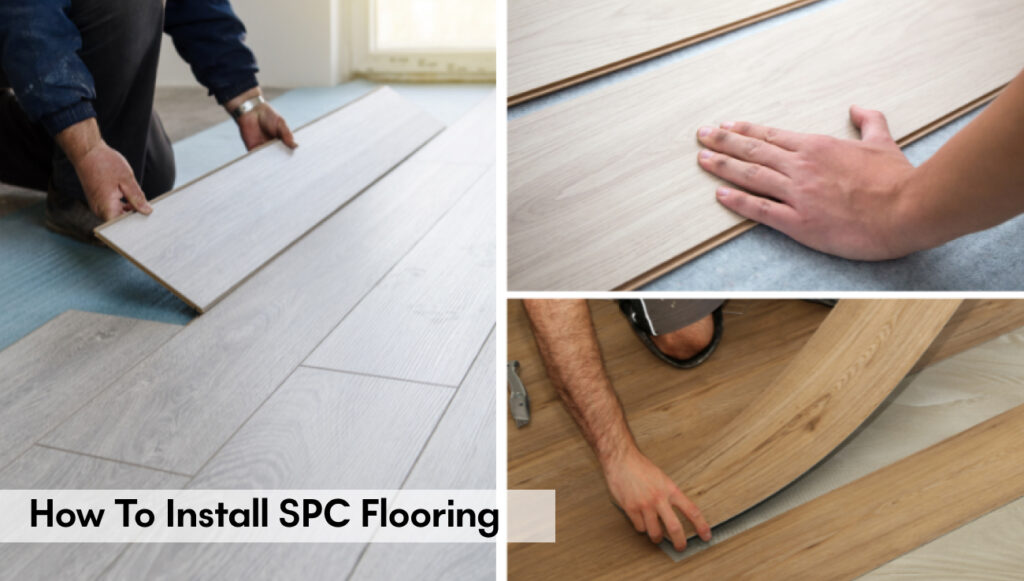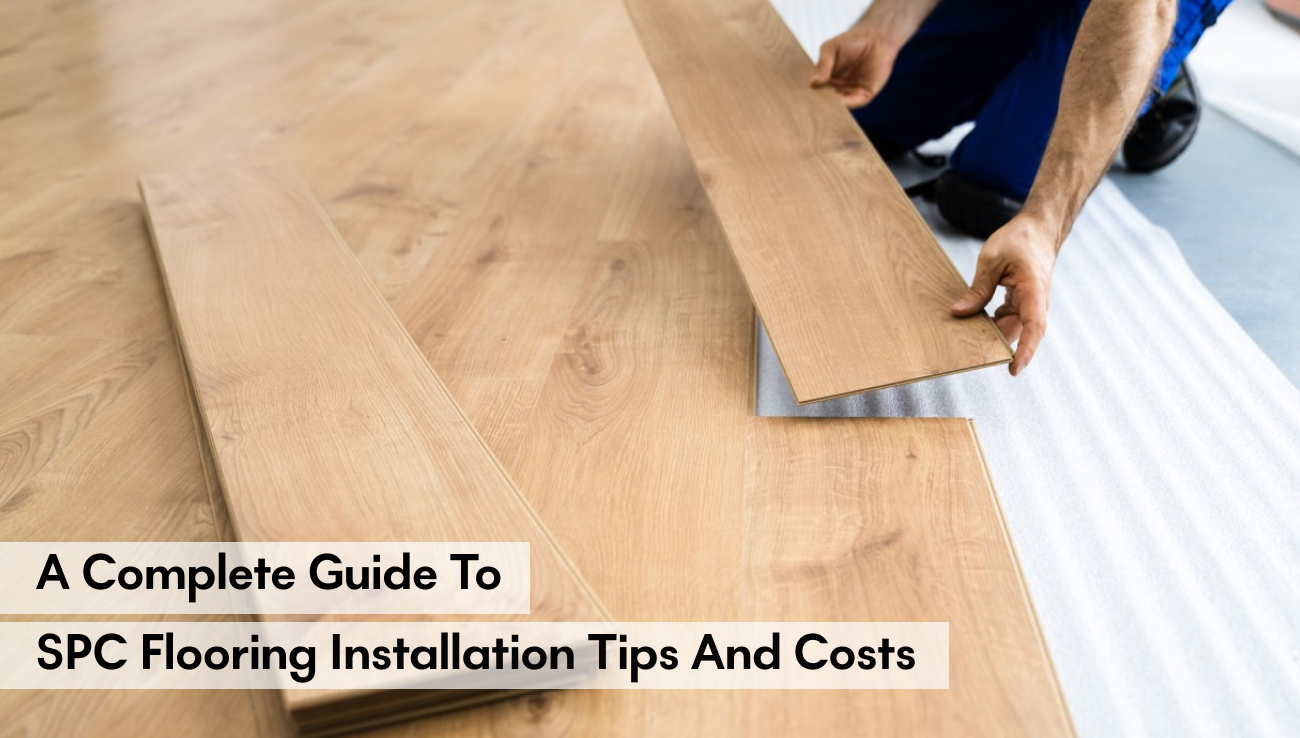Your greatest bet for replacing your flooring may be SPC flooring. Want to know why it is your greatest bet? It is one of the most liked flooring options, whether for your home or office. It is the flooring that you can trust. Why? It is stylish, can last up to decades, and is very easy or straightforward to install.
Well, you’ve come across the right post. This blog will clear up all your doubts about SPC Flooring—questions like the installation process, price, and why it could best fit your space.
What is SPC Flooring?
SPC Vinyl flooring has a watertight, extremely durable core of stabilizers and limestone. SPC flooring is an excellent choice for places with significant foot traffic or dampness because it offers better stability and temperature tolerance than ordinary vinyl flooring.
How to Install SPC Flooring

Installing SPC floors is a straightforward task. You can DIY it with ease. But, you should engage an expert if you need more equipment or skills to complete the task yourself. However, suppose you decide to walk on instead and change your mind. Here’s the process you need to follow:
1. Preparation
Preparing the floor where you want your flooring to be installed comes first. The floor should be ready before we start laying the SPC floor.
Acclimate the Flooring: Give the SPC vinyl flooring some time before laying it. At best, give it 48 hours to adjust to the room’s humidity and temperature. This helps prevent any expansion or contraction after SPC floor installation.
Assemble the Subfloor: Ensure it is level, dry, and clean. Debris, dampness, and unevenness can all impact the SPC floor installation process and outcome.
Measure the Area: Measure the room to determine the flooring you need. Add an extra 10% to account for cuts and waste.
2. Installation Process
Now comes the second part, which is said to be the trickiest. But it’s not. Have confidence, and once you’ve cleared or prepared the space in which you’ll be installing the tiles, let’s start the installation.
Begin with the First Row: Lay SPC Floor along the longest wall—place spacers between the wall and the flooring, allowing expansion.
Click-Lock Mechanism: SPC floor installation typically features a click-lock system. Press down until the next plank snaps into place after lining up its tongue with the groove of the previously laid plank.
Stagger the Planks: Stagger the planks by starting each row with a different length to achieve a natural look. This also provides additional stability to the floor.
Cutting the Planks: You must cut the planks to fit around obstructions or at the end of rows. Use a saw or a utility knife for accurate cutting.
Install Transition Molding: Add transition moldings to ensure a seamless transition between your SPC floor and another type of flooring.
3. Finishing Touches
Now that you have laid all the planks, it’s time that we wrap it up swiftly.
Remove Spacers: After the floor is complete and you’ve laid all the planks, remove the spacers from the edges you placed.
Install Baseboards: Reinstall baseboards or trim to cover the expansion gap around the room.
Clean the Floor: SPC floor installation can create a lot of dust, so clean your newly installed SPC floor.
How Much Does SPC Flooring Installation Cost?
Comprehending the expenses linked to installing the flooring is vital for project planning. This is a summary of what to anticipate.
Material Costs
The cost of SPC flooring varies depending on the brand, quality, and style you choose. SPC vinyl flooring ranges from $2 to $5 per square foot. Higher-end options with more realistic textures and patterns may cost more.
Installation Costs
If you choose to work with an expert, we must discuss the cost of the SPC flooring installation. The price per square foot for installing this flooring varies from $1.50 to $3. Recall that it is subject to alteration based on market conditions. Remember to factor in the additional costs for adhesive, underlayment, and any other expert work that may be required.
Additional Costs
Make careful to factor in any extra expenses that can occur during the installation process:
Subfloor Preparation: If your subfloor needs to be leveled or repaired, the service cost may increase by $1 to $3 per square foot.
Trim & Moldings: Baseboard and transition molding installation typically cost $1 to $2 per linear foot.
Waste Factor: As mentioned earlier, it is advisable to purchase an additional 10% of flooring to account for waste, which can increase the material cost.
DIY vs. Professional Installation
When it comes to installing SPC flooring, you have the option of doing it yourself or hiring a professional for a flooring installation guide. Each option has its pros and cons.
DIY Installation
Installing the flooring yourself may be more affordable since the installation guide may reduce labor expenses. Thanks to the click-lock mechanism included in most SPC products, installation is relatively simple, even for novices. However, it does require time, work, and the appropriate equipment to guarantee a polished finish.
Pros:
Cost Savings: You can save on labor costs by handling the installation yourself using the flooring installation guide.
Control Over the Process: You can work independently and ensure the installation meets your standards.
Cons:
Time-consuming: Installing it yourself may take longer, particularly if you need to become more experienced.
Error risk: Installation errors might result in problems down the road, such as gaps or uneven floors.
Professional Installation
Want to avoid headaches or save time? Hire a professional to do your work. Also, hiring an expert ensures a high-quality installation. The experts are endowed with knowledge and insights about flooring. They can easily manage any difficulties that might occur during the installation.
Pros:
Expertise: Qualified individuals have the necessary knowledge and experience to install your SPC floor successfully.
Warranty: Many specialists offer warranties to provide clients peace of mind.
Cons:
Higher Cost: Professional installation costs more due to labor fees.
Less Control: You must rely on the professional’s schedule and availability.
Is SPC Flooring Right for You?
Water-resistant, fashionable, and durable, SPC flooring is an excellent choice for any space in your house or business. SPC vinyl flooring might be an affordable option to make your floors appear better and work better. You can choose to perform it yourself or hire an expert. Ironed to make an educated option that fits your style preferences and financial constraints. Visit BuildMyPlace for all your SPC flooring needs.
Frequently Asked Questions:
Q. What is SPC flooring?
A. Stone plastic composite, or SPC for short, has a core of plasticizers, polyvinyl chloride, and around 60% calcium carbonate, or limestone.
Q. Is SPC flooring expensive?
A. SPC flooring costs $4 to $7 per square foot, less expensive than stone tile and hardwood. However, it is competitive with laminate.
Q. Is SPC waterproof?
A. SPC flooring is 100% waterproof and has an enhanced stability structure.
Q. Is SPC flooring good for health?
A. Since SPC flooring doesn’t have formaldehyde or other dangerous ingredients, it is not poisonous.
Q. Will SPC flooring crack?
A. In general, SPC flooring is not prone to cracking under normal circumstances.
